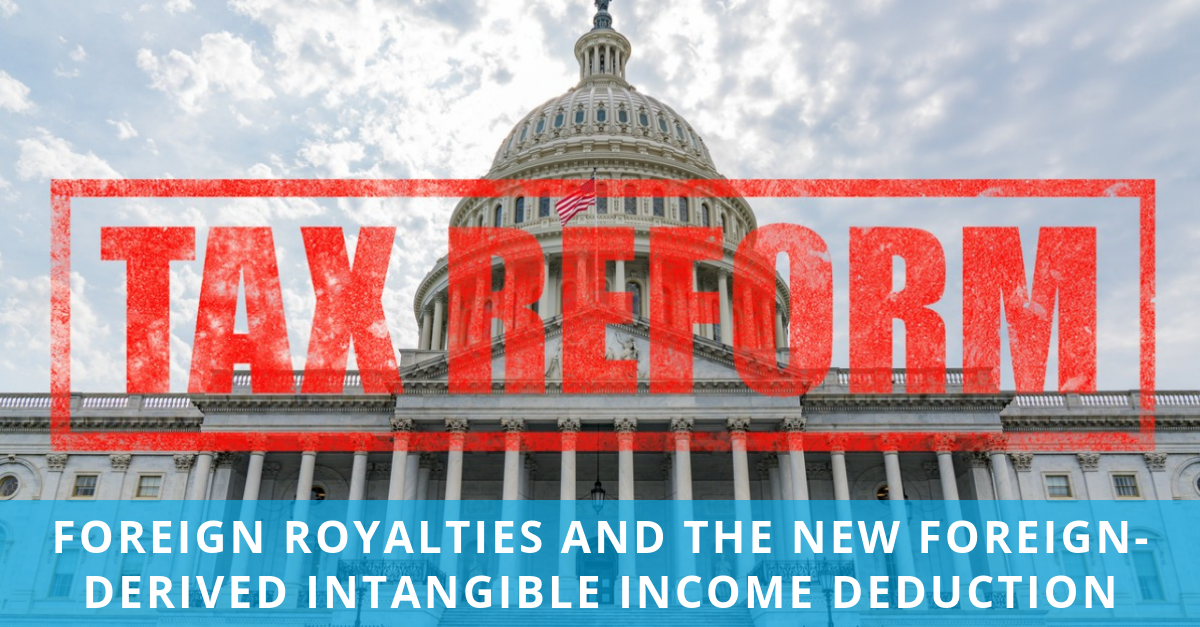Part of the TCJA of 2017 was an incentive for retaining intangibles in the US rather than transferring them overseas (or even for bringing them back). There is a 37.5% deduction for a domestic corporation that has foreign-derived intangible income (FDII). The deduction is based on the income derived from the sale of property or from services provided to a non-US person. This provision is similar to the GILTI provisions that look at income in excess of a 10% return on qualified business asset investments (QBAI).
Royalties as FDII
While it was clear that tangible property sales were FDII, there was some concern about whether foreign royalty income was also included in this category. The regulations clarified this point and have examples that confirm this is the case.
Foreign Use Requirement
While the rules for the FDII are similar to the DISC rules on being able to demonstrate foreign use, the DISC rules generally did not apply to intangible property (royalties). For tangible product, there was a destination test that was applied. But for royalties, the foreign use test requires a little more documentation from the recipient of the intangible property than mere shipping documentation. If total gross receipts are less than $10 million, then shipping address documentation is sufficient.
Documentation Requirements
The regulations are very specific about what is needed, and requires more detailed information when a related party is involved. Even with unrelated parties, the domestic corporation must be able to provide an annual, reasonable projection of use of the intangible. The following are selected parts of the applicable regulations:
Reg. Sec. 1.250(b)-4(e)(2) Determination of foreign use
(i) In general.— A sale of intangible property is for a foreign use only to the extent that the intangible property generates revenue from exploitation outside the United States. …. For intangible property used in the development, manufacture, sale, or distribution of a product, the intangible property is treated as exploited at the location of the end user when the product is sold to the end user. Paragraphs (e)(2)(ii) and (iii) of this section provide rules for how and when to determine revenue from exploitation with respect to different types of sales of intangible property.
(ii) Sales in exchange for periodic payments.— In the case of a sale of intangible property to a foreign person in exchange for periodic payments, the … foreign use is determined on an annual basis based on the actual revenue earned by the recipient for the taxable year in which a periodic payment is received.
(iii) Sales in exchange for a lump sum.— In the case of a sale of intangible property to a foreign person for a lump sum, the … foreign use is determined based on the ratio of the total net present value of revenue the seller would have reasonably expected to earn from the exploitation of the intangible property outside the United States to the total net present value of revenue the seller would have reasonably expected to earn ….
(3) Documentation of foreign use of intangible property
(i) Documentation for sales for periodic payments.— Except as provided in paragraph (e)(3)(ii) of this section, a seller establishes the extent to which a sale … is for a foreign use by obtaining one or more of the following types of documentation with respect to the sale—
(A) A written statement from the recipient providing the amount of the annual revenue from sales or sublicenses of the intangible property or sales of products with respect to which the intangible property is used that is generated as a result of exploitation of the intangible property outside the United States and the total amount of revenue from such sales or sublicenses worldwide;
(B) A binding contract for the sale of the intangible property that provides that the intangible property can be exploited solely outside the United States;
(C) Audited financial statements or annual reports of the recipient stating the amount of annual revenue earned within the United States and outside the United States from sales of products with respect to which the intangible property is used;
(D) Any statements or documents used by the seller and the recipient to determine the amount of payment due for exploitation of the intangible property if those statements or documents provide reliable data on revenue earned within the United States and outside the United States; or
(E) Any other forms of documentation as prescribed by the Secretary in forms, instructions, or other guidance.
(ii) Certain sales to foreign unrelated parties.— In the case of a sale … that are not contingent on revenue or profit to a foreign unrelated party where the seller is unable to obtain the documentation described in paragraph (e)(3)(i) of this section without undue burden, a seller establishes the extent to which the sale … is for a foreign use using the principles of paragraph (e)(3)(iii) of this section, except that the seller must make reasonable projections on an annual basis.
(iii) Documentation for sales in exchange for a lump sum.— A seller establishes the extent to which a sale … is for a foreign use through documentation containing reasonable projections of the amount and location of revenue that the seller would have reasonably expected to earn from exploiting the intangible property. To be considered reasonable, the projections must be consistent with the financial data and projections used by the seller to determine the price it sold the intangible property to the foreign person.
Take Aways:
- If you have foreign royalties, you may want to consider whether the FDII is better for your situation than the establishment of an IC-DISC, which is also an export incentive. Type and amount of documentation may have an impact on this decision, as well as how other recent tax law changes (e.g., GILTI) might benefit the domestic corporation and its shareholders.
- Any foreign royalty agreements should be reviewed to determine if modifications should be made to require the foreign person to provide the documentation required under the FDII rules.
- The FDII benefit is not available to individuals, including partnerships, S Corporations or other flow through entities.
Please contact us for assistance with these complicated calculations.
Thank you.




